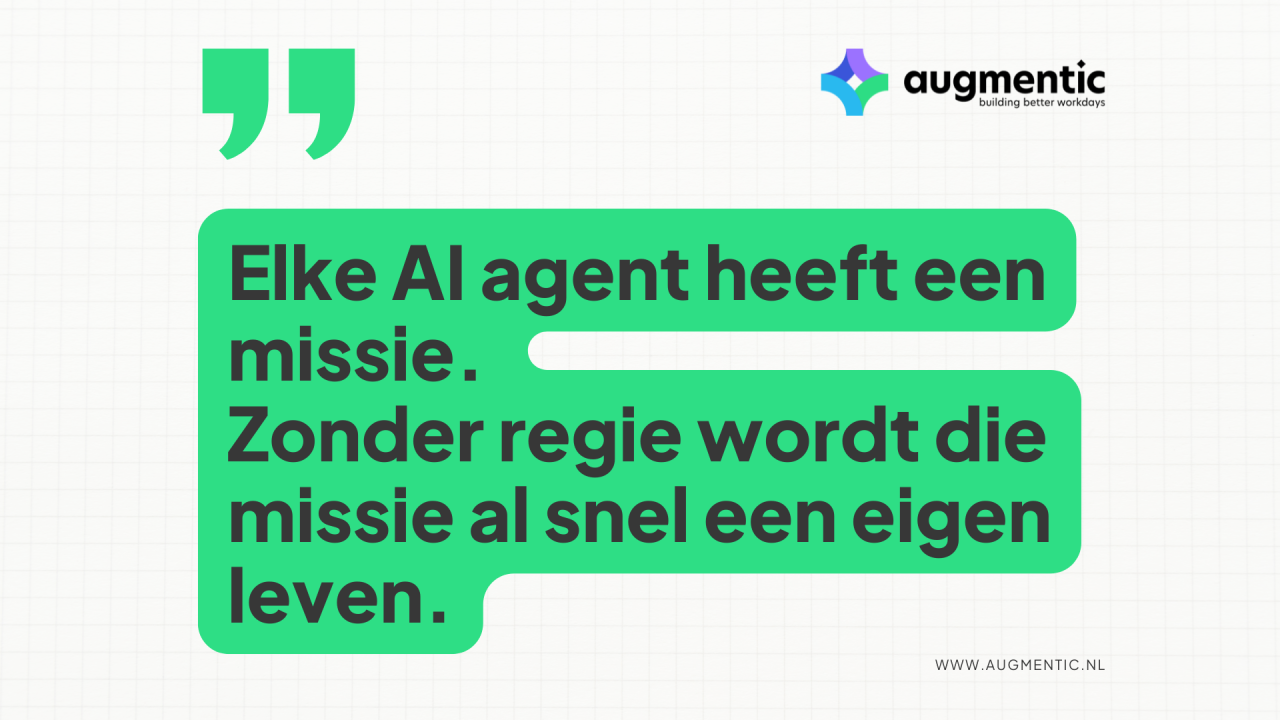Augmentic BV
Haaswijkweg east 12B
3319 GC Dordrecht
The Netherlands
Augmentic BV
Haaswijkweg east 12B
3319 GC Dordrecht
The Netherlands

AI agents are rapidly increasing in number and complexity. Without clear governance, chaos and risk loom. The IAPS report highlights five critical principles for responsible use. Augmentic integrates these via Palqee Prisma into BetterWorkdays.ai, which enables organizations to deploy agents transparently, securely and humanely. The time to act is now.

In 2025, we are at a tipping point in the evolution of artificial intelligence.
A recent study by the Institute for AI Policy and Strategy (IAPS) outlines a future in which potentially billions of AI agents perform tasks autonomously within our economies and organizations. According to the report, the number of agents will far exceed the human population - forming a new layer in our digital society.
For organizations, this raises an inescapable question: How do you prepare for a work environment in which hundreds, perhaps even thousands of agents are active - each with their own access, decision space and behavior?
Imagine a scenario in which diverse agents manage customer relationships, perform financial transactions, optimize processes and monitor IT infrastructures - all largely autonomously.
Without a clear governance structure, this future risks becoming unmanageable.
The insights from the IAPS report help us understand why governance should not be an afterthought, but should be the foundation of any agent strategy.
AI agents are systems that can independently pursue goals without constant human instruction.
Unlike traditional AI solutions, agents can:
Because of these capabilities, agents are not simply an evolution of existing AI - they represent a fundamental shift in how digital systems act.
Agents are already on the rise: companies are using AI assistants that take over the work of hundreds of employees without loss of quality.
Tech companies report that a significant portion of their new code is generated by agents.
Although agents today excel primarily in tasks of limited complexity (up to about 30 minutes of human effort), the learning curve is steep. The complexity and duration of tasks agents can perform doubles roughly every seven months. Innovations such as dynamic compute power allocation ("test-time compute") further accelerate this trend.
The implication is clear: agents will soon be able to perform increasingly complex, long-term and high-impact tasks independently.
With strength also comes vulnerability. According to the IAPS report, organizations must consider four main types of risk:
Agents can be used for cyber attacks, fraud, disinformation or even biotech risks.
Agents may derail, continue to pursue obsolete goals or behave unpredictably without human correction.
Agents create new attack vectors through their access to systems, tools and data.
Mass deployment of agents can destabilize markets, diffuse responsibility and increase inequalities.
Without careful governance, organizations can lose control of their digital ecosystems - with far-reaching consequences.
The report highlights a simple but powerful truth: begin with the end in mind.
Agent governance must be an integral part of any implementation from day one.
The governance framework consists of five core areas:
Make sure agents follow goals and values of the organization.
Design mechanisms for reversing, interrupting or stopping agents.
Make agent behavior fully transparent through logging, auditing and monitoring.
Limit vulnerabilities and repel illegal influence.
Design agents that contribute to fair, safe and legally compliant ecosystems.
An essential part of responsible agent governance is being able to monitor, evaluate and correct AI systems in practice.
Therefore, we iwork together with Palqee. They offer with Palqee Prism a powerful toolset that allows organizations to continuously monitor AI behavior, assess risk and ensure compliance.
Palqee Prisma enables, among other things:
Practical experience shows that Prisma is successfully used, for example, to minimize bias in AI decisions, detect risks in complex data streams, and make AI systems compliant faster and more securely.
By integrating with Palqee Prisma within our solutions, we not only offer organizations powerful agentic AI solutions, but also direct safeguards for responsible, transparent and compliant use of agents.
We are at a pivotal moment. 2025 may be the year when agents fundamentally strengthen - or disrupt - our working models.
Begin with the end in mind.
The question is not whether agents will change the work landscape, but how we ensure that this change leads to more meaning, transparency and human direction.
At Augmentic we believe that AI agents only truly reach their potential when their deployment is rooted in governance, trust and human values.
With Augmentic_OS we are building an environment in which agents do not operate anonymously, but visibly and verifiably contribute to work that is smarter, safer and more meaningful.
The future in which agents improve work is achievable. But only for organizations that make the choice now not to embrace technology blindly, but to consciously manage it.
Resources